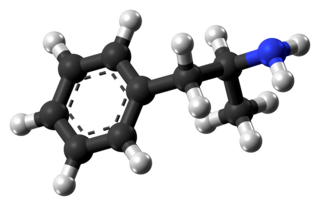
Amphetamine is a strong central nervous system (CNS) stimulant that is used in the treatment of attention deficit hyperactivity disorder (ADHD), narcolepsy, and obesity. Amphetamine was discovered in 1887 and exists as two enantiomers: levoamphetamine and dextroamphetamine. Amphetamine properly refers to a specific chemical, the racemic free base, which is equal parts of the two enantiomers in their pure amine forms. The term is frequently used informally to refer to any combination of the enantiomers, or to either of them alone. Historically, it has been used to treat nasal congestion and depression. Amphetamine is also used as an athletic performance enhancer and cognitive enhancer, and recreationally as an aphrodisiac and euphoriant. It is a prescription drug in many countries, and unauthorized possession and distribution of amphetamine are often tightly controlled due to the significant health risks associated with recreational use.

Stimulants is an overarching term that covers many drugs including those that increase activity of the central nervous system and the body, drugs that are pleasurable and invigorating, or drugs that have sympathomimetic effects. Stimulants are widely used throughout the world as prescription medicines as well as without a prescription as performance-enhancing or recreational drugs. Among narcotics, stimulants produce a noticeable crash or comedown at the end of their effects. The most frequently prescribed stimulants as of 2013 were lisdexamfetamine (Vyvanse), methylphenidate (Ritalin), and amphetamine (Adderall). It was estimated in 2015 that the percentage of the world population that had used cocaine during a year was 0.4%. For the category "amphetamines and prescription stimulants" the value was 0.7%, and for MDMA 0.4%.

Dextroamphetamine is a central nervous system (CNS) stimulant and an amphetamine enantiomer that is prescribed for the treatment of attention deficit hyperactivity disorder (ADHD) and narcolepsy. It is also used as an athletic performance and cognitive enhancer, and recreationally as an aphrodisiac and euphoriant.

Empathogens or entactogens are a class of psychoactive drugs that produce experiences of emotional communion, oneness, relatedness, emotional openness—that is, empathy or sympathy—as particularly observed and reported for experiences with 3,4-methylenedioxymethamphetamine (MDMA). This class of drug is distinguished from the classes of hallucinogen or psychedelic, and amphetamine or stimulants. Major members of this class include MDMA, MDA, MDEA, MDOH, MBDB, 6-APB, methylone, mephedrone, GBL, αMT, and αET, MDAI among others. Most entactogens are phenethylamines and amphetamines, although several, such as αMT and αET, are tryptamines. When referring to MDMA and its counterparts, the term MDxx is often used. Entactogens are sometimes incorrectly referred to as hallucinogens or stimulants, although many entactogens such as ecstasy exhibit psychedelic or stimulant properties as well.
Stimulant psychosis is a mental disorder characterized by psychotic symptoms which involves and typically occurs following an overdose or several day 'binge' on psychostimulants; however, it has also been reported to occur in approximately 0.1% of individuals, within the first several weeks after starting amphetamine or methylphenidate therapy. Methamphetamine psychosis, or long-term effects of stimulant use in the brain, depend upon genetics and may persist for some time.

Adderall and Mydayis are trade names for a combination drug called mixed amphetamine salts containing four salts of amphetamine. The mixture is composed of equal parts racemic amphetamine and dextroamphetamine, which produces a (3:1) ratio between dextroamphetamine and levoamphetamine, the two enantiomers of amphetamine. Both enantiomers are stimulants, but differ enough to give Adderall an effects profile distinct from those of racemic amphetamine or dextroamphetamine, which are marketed as Evekeo and Dexedrine/Zenzedi, respectively. Adderall is used in the treatment of attention deficit hyperactivity disorder (ADHD) and narcolepsy. It is also used illicitly as an athletic performance enhancer, cognitive enhancer, appetite suppressant, and recreationally as a euphoriant. It is a central nervous system (CNS) stimulant of the phenethylamine class.

Propylhexedrine, sold under the brand name Benzedrex, is a nasal decongestant, appetite suppressant, and psychostimulant medication. It is used medicinally for relief of congestion due to colds, allergies and allergic rhinitis.

Phenmetrazine is a stimulant drug first synthesized in 1952 and originally used as an appetite suppressant, but withdrawn from the market in the 1980s due to widespread abuse. It was initially replaced by its analogue phendimetrazine which functions as a prodrug to phenmetrazine, but now it is rarely prescribed, due to concerns of abuse and addiction. Chemically, phenmetrazine is a substituted amphetamine containing a morpholine ring.

Clobenzorex is a stimulant drug of the amphetamine chemical class used as an appetite suppressant. The drug is legally distributed in Mexico under the trade name Asenlix by Aventis.

Lisdexamfetamine, sold under the brand name Vyvanse among others, is a stimulant medication that is mainly used to treat attention deficit hyperactivity disorder (ADHD) in people over the age of five as well as moderate-to-severe binge eating disorder in adults. Lisdexamfetamine is taken by mouth. Its effects generally begin within 2 hours and last for up to 14 hours. In the United Kingdom, it is usually less preferred than methylphenidate for the treatment of children.

Methamphetamine is a potent central nervous system (CNS) stimulant that is mainly used as a recreational drug and less commonly as a second-line treatment for attention deficit hyperactivity disorder and obesity. Methamphetamine was discovered in 1893 and exists as two enantiomers: levo-methamphetamine and dextro-methamphetamine. Methamphetamine properly refers to a specific chemical substance, the racemic free base, which is an equal mixture of levomethamphetamine and dextromethamphetamine in their pure amine forms. It is rarely prescribed over concerns involving human neurotoxicity and potential for recreational use as an aphrodisiac and euphoriant, among other concerns, as well as the availability of safer substitute drugs with comparable treatment efficacy such as Adderall and Vyvanse. Dextromethamphetamine is a stronger CNS stimulant than levomethamphetamine.

Mefenorex is a stimulant drug which was used as an appetite suppressant. It is an amphetamine derivative which was developed in the 1970s and used for the treatment of obesity. Mefenorex produces amphetamine as a metabolite, and has been withdrawn in many countries despite having only mild stimulant effects and relatively little abuse potential.

Amfetaminil is a stimulant drug derived from amphetamine, which was developed in the 1970s and used for the treatment of obesity, ADHD, and narcolepsy. It has largely been withdrawn from clinical use following problems with abuse. The drug is a prodrug to amphetamine.

2-Benzylpiperidine is a stimulant drug of the piperidine class. It is similar in structure to other drugs such as methylphenidate and desoxypipradrol but around one twentieth as potent, and while it boosts norepinephrine levels to around the same extent as d-amphetamine, it has very little effect on dopamine levels, with its binding affinity for the dopamine transporter around 175 times lower than for the noradrenaline transporter. 2-benzylpiperidine is little used as a stimulant, with its main use being as a synthetic intermediate in the manufacture of other drugs.

Amfonelic acid is a research chemical and dopaminergic stimulant with antibiotic properties.
Substituted amphetamines are a class of compounds based upon the amphetamine structure; it includes all derivative compounds which are formed by replacing, or substituting, one or more hydrogen atoms in the amphetamine core structure with substituents. The compounds in this class span a variety of pharmacological subclasses, including stimulants, empathogens, and hallucinogens, among others. Examples of substituted amphetamines are amphetamine (itself), methamphetamine, ephedrine, cathinone, phentermine, mephentermine, bupropion, methoxyphenamine, selegiline, amfepramone (diethylpropion), pyrovalerone, MDMA (ecstasy), and DOM (STP).

Amphetamine dependence refers to a state of psychological dependence on a drug in the amphetamine class. Stimulants such as amphetamines and cocaine do not cause physical dependence.
Amphetamine and methamphetamine are central nervous system stimulants used to treat a variety of conditions. When used recreationally, they are colloquially known as "speed." Amphetamine was first synthesized in 1887 in Germany by Romanian chemist Lazăr Edeleanu, who named it phenylisopropylamine. Around the same time, Japanese organic chemist Nagai Nagayoshi isolated ephedrine from the Chinese ephedra plant and later developed a method for ephedrine synthesis. Methamphetamine was synthesized from ephedrine in 1893 by Nagayoshi. Neither drug had a pharmacological use until 1934, when Smith, Kline & French began selling amphetamine as an inhaler under the trade name Benzedrine for congestion.

para-Chloromethamphetamine is a stimulant that is the N-methyl derivative and prodrug of the neurotoxic drug para-chloroamphetamine (4-CA). It has been found to decrease serotonin in rats. Further investigation into the long-term effects of chloroamphetamines discovered that administration of 4-CMA caused a prolonged reduction in the levels of serotonin and the activity of tryptophan hydroxylase in the brain one month after injection of a single dose of the drug.
Amphetamine type stimulants (ATS) are a group of synthetic drugs that are chemical derivatives of the parent compound alpha-methylphenethylamine, also known as amphetamine. Common ATS includes amphetamine, methamphetamine, ephedrine, pseudoephedrine, 3,4-methylenedioxymethamphetamine (MDMA), 3,4-methylenedioxyamphetamine (MDA) and 3,4-methylenedioxyethylamphetamine (MDEA). ATS when used illicitly has street names including ice, meth, crystal, crank, bennies, and speed. Within the group of amphetamine-type stimulants, there are also prescription drugs including mixed amphetamine salts, dextroamphetamine, and lisdexamfetamine.
















